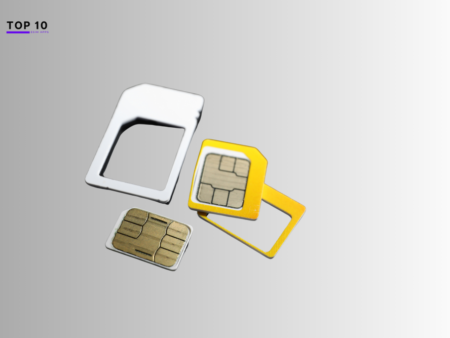eSIM, the revolutionary technology that eliminates the need for a physical SIM card, offers a seamless solution for managing cellular plans on your device. With eSIM, you can experience the flexibility of switching carriers and plans without the hassle of swapping SIM cards. In this guide, we will walk you through the basics of using eSIM on your device, from setup to activation.

Key Takeaways:
- Learn how to use eSIM to manage your cellular plans.
- Understand the benefits of eSIM, including flexibility and convenience.
- Follow the step-by-step guide to activate eSIM on your device.
- Discover the compatibility of eSIM with various devices.
- Explore the future potential of eSIM in the ever-evolving world of connectivity.
What is eSIM?
eSIM, or embedded SIM, is a revolutionary technology that eliminates the need for a physical SIM card in your device. It is a chip that is soldered directly onto the device’s board and functions as a SIM card. This embedded SIM offers several benefits and advantages over traditional SIM cards.
One of the main benefits of eSIM is its smaller size, which allows for sleeker and more compact device designs. Additionally, eSIM enables remote management capabilities, meaning you can switch carriers and plans without physically swapping out SIM cards. This flexibility is especially useful for frequent travelers or those who need to switch between multiple carriers.
eSIM also supports remote SIM provisioning, which further enhances its convenience. With remote SIM provisioning, you can easily activate and manage your eSIM from anywhere, without the need for a physical visit to a carrier store. This streamlined activation process saves time and provides greater accessibility for users.
Overall, eSIM technology offers a new level of flexibility, convenience, and efficiency in managing cellular connectivity on your device. Its smaller size, remote management capabilities, and support for remote SIM provisioning make it a compelling choice for users looking for a more seamless and hassle-free mobile experience.
How to Activate eSIM on Your Device
Activating eSIM on your device is a straightforward process that involves following specific steps provided by your carrier. The activation process may vary slightly depending on your device and the carrier you are using. Typically, you will receive activation instructions via email or from customer support.
One common method of activating eSIM is by scanning a QR code provided by your carrier. This QR code contains all the necessary information to activate your eSIM. Simply open your device’s camera app, scan the QR code, and follow the prompts to complete the activation.
If you do not have access to a QR code, you can also activate eSIM by entering the activation details manually. Your carrier will provide you with an activation code that you can enter into your device’s settings. Make sure to carefully enter the code as it appears, and once you have entered the code, follow the prompts to complete the activation process.
Table: eSIM Activation Process
| Step | Activation Method |
|---|---|
| 1 | Scan the provided QR code using your device’s camera app |
| 2 | Follow the prompts on your device to complete the activation |
| 3 | If no QR code is available, enter the provided activation code manually |
| 4 | Follow the prompts on your device to complete the activation |
After completing the activation, it is recommended to make a test call to ensure that your device is properly connected to the cellular network. This will ensure that your eSIM is functioning correctly and that you can make and receive calls without any issues.
Once activated, your eSIM will provide you with the flexibility to easily switch carriers and manage your service plans. It eliminates the need for physical SIM cards and simplifies the process of managing your cellular connectivity on your device.
eSIM Compatibility and Supported Devices
eSIM technology is supported on various devices, including smartphones, tablets, and laptops. This revolutionary technology offers users the convenience of managing multiple carriers and service plans without the need for physical SIM cards. Let’s take a closer look at the different devices that support eSIM:
eSIM-Enabled Smartphones
eSIM is compatible with a range of popular smartphones, including iPhones and Google Pixels. These devices allow users to activate eSIMs and switch between carriers seamlessly, providing flexibility and convenience in managing their cellular connectivity.
eSIM-Supported Tablets
Tablets from brands like Apple, Samsung, and others also support eSIM technology. With an eSIM-enabled tablet, users can easily add cellular plans to their device, ensuring they stay connected even when Wi-Fi is not available. This is particularly useful for those who require constant internet access on the go.
eSIM Laptops
In addition to smartphones and tablets, eSIM is also available on select laptops from renowned brands like Apple, Acer, Asus, Dell, HP, Lenovo, and Samsung. eSIM-enabled laptops provide users with the flexibility to connect to cellular networks without the hassle of physical SIM cards, making them ideal for remote workers or frequent travelers.
Before using eSIM on your device, it’s important to check compatibility with your specific device and carrier. Not all devices and carriers fully support eSIM technology, so it’s essential to ensure that your device is compatible before attempting to use eSIM. By utilizing eSIM technology, users can enjoy the benefits of convenience, flexibility, and seamless connectivity.
| Device Type | Supported Brands |
|---|---|
| Smartphones | Apple (iPhone), Google (Pixel), and more |
| Tablets | Apple, Samsung, and more |
| Laptops | Apple, Acer, Asus, Dell, HP, Lenovo, Samsung, and more |
Benefits of Using eSIM
eSIM technology offers a range of advantages that make it an attractive option for device users. One of the key benefits is the flexibility it provides. With eSIM, users can easily switch between different plans and carriers, giving them the freedom to choose the most suitable option for their needs. This flexibility is particularly beneficial for travelers, as it allows them to switch to a local plan without having to physically change their SIM card.
Another advantage of eSIM is its ability to enable dual SIM functionality on compatible devices. This means that users can have two separate phone numbers and plans on a single device, such as a personal line and a work line. It eliminates the need to carry around multiple devices or constantly swap SIM cards, providing convenience and efficiency.
In addition to these benefits, eSIM eliminates the hassle of physical SIM card handling. There’s no need to worry about losing or damaging a SIM card, and the process of activating and managing service plans becomes much simpler. eSIM also offers more flexibility in managing service plans, allowing users to easily add or remove plans as needed.
Advantages of Using eSIM:
- Flexibility to switch between plans and carriers
- Dual SIM functionality for separate personal and work lines
- No physical SIM card handling
- Easy activation and management of service plans
Overall, eSIM technology revolutionizes the way we manage cellular connectivity on our devices. Its advantages in terms of flexibility, dual SIM functionality, and convenience make it a desirable choice for users looking for a more streamlined and efficient experience. As eSIM adoption continues to grow and more devices and carriers support this technology, it is set to become an essential feature in the future of connectivity.
Setting Up eSIM Through Carrier Activation
Setting up eSIM on your device can be done conveniently through carrier activation. This process allows for a seamless and automatic setup, ensuring that your eSIM is ready to use in no time. When purchasing a device from a carrier that supports eSIM, the eSIM is assigned automatically during the activation process. All you need to do is connect your device to Wi-Fi, and you will receive an eSIM activation notification to complete the setup.
To ensure a successful activation, it is recommended to follow the instructions provided by your carrier. Once the eSIM is activated, it is advisable to make a test call to verify cellular connectivity. It’s important to note that the activation process may vary slightly depending on your device and carrier, so it’s always best to refer to the specific instructions provided to you.
By setting up eSIM through carrier activation, you can enjoy the benefits of this innovative technology without any complications. The simplicity and convenience offered by this method make it a popular choice among users who want to experience the advantages of eSIM without the hassle of manual setup.
Example of eSIM Activation Process:
| Step | Description |
|---|---|
| Step 1 | Purchase a device from a carrier that supports eSIM. |
| Step 2 | Connect your device to Wi-Fi. |
| Step 3 | Receive an eSIM activation notification and follow the prompts to complete the setup. |
| Step 4 | Make a test call to ensure cellular connectivity. |
Setting Up eSIM Through Quick Transfer
Setting up eSIM on your device can also be done through the convenient Quick Transfer option. This feature allows you to transfer the eSIM from your previous device to your new one without having to contact your carrier. The Quick Transfer process is simple and user-friendly, ensuring a seamless transition to your new device.
To begin the eSIM transfer process, navigate to the settings on your new device and look for the option to transfer an eSIM. Select this option and follow the on-screen instructions. You will be prompted to select the transfer number and confirm the transfer on both the previous and new devices. Once the transfer is confirmed, the eSIM will be activated on your new device and connected to your carrier’s network.
With Quick Transfer, you can also transfer not only your eSIM but also your data and settings. This means that you can easily migrate your personal information, contacts, and preferences from your previous device to your new one, ensuring a smooth and hassle-free transition. The Quick Transfer process saves you time and effort, making it a convenient option for setting up eSIM on your new device.
Benefits of Using Quick Transfer for eSIM Setup:
- Saves time and effort by transferring eSIM, data, and settings from your previous device to your new device
- Ensures a seamless transition to your new device without the need to contact your carrier
- Allows you to quickly activate and connect your eSIM to your carrier’s network
- Provides a user-friendly and efficient way to set up eSIM on your new device
| Benefits | Quick Transfer |
|---|---|
| Saves time and effort | ✓ |
| No need to contact carrier | ✓ |
| Seamless transition to new device | ✓ |
| Quick activation and connection | ✓ |
| User-friendly setup | ✓ |
By utilizing the Quick Transfer option for eSIM setup, you can easily transfer your eSIM, data, and settings to your new device, saving you time and ensuring a seamless transition. This convenient feature provides a user-friendly way to activate and connect your eSIM to your carrier’s network, without the need to contact your carrier. Take advantage of Quick Transfer and enjoy the benefits of setting up your eSIM hassle-free.
Adding Additional eSIMs to Your Device
Once you have successfully activated the primary carrier’s eSIM on your device, you can add additional eSIMs to expand your connectivity options. Adding more eSIMs allows you to manage multiple lines or plans on a single device, offering greater flexibility and convenience.
To add an additional eSIM, follow these steps:
- Open the settings menu on your device.
- Select the option for “Cellular” or “Mobile Data.”
- Choose the “Add Cellular Plan” or similar option.
- Scan the QR code provided by your carrier or enter the activation details manually.
- Follow any additional prompts or instructions to complete the setup.
By scanning the QR code or entering the activation details, the additional eSIM will be linked to your device, and you can start using the new line or plan. To manage multiple eSIMs on your device, you can customize the labels for each eSIM. This allows you to easily distinguish between different lines or plans, making it simpler to manage your connectivity.
| eSIM Label | Carrier | Plan |
|---|---|---|
| Personal Line | Carrier A | Unlimited Data |
| Work Line | Carrier B | Business Plan |
In the example table above, you can see how labels can be customized to differentiate between a personal line with unlimited data from Carrier A and a work line with a business plan from Carrier B. This simple labeling system helps you keep track of your different eSIMs and their respective carriers and plans.
Additionally, you can set default voice line and data preferences for each eSIM. This allows you to specify which eSIM to use for calls and which one should be used for data by default. By customizing these preferences, you can streamline your connectivity experience and ensure your device uses the desired eSIM for specific functions.
Adding multiple eSIMs to your device provides the flexibility to manage multiple lines or plans effortlessly. With customizable labels and preferences, you can easily switch between eSIMs and make the most of this innovative technology.
Managing Use and Preferences for eSIMs
When it comes to using eSIMs on your device, managing your preferences allows you to tailor your connectivity experience to your specific needs. From data settings to voice preferences, here’s a closer look at how you can personalize your eSIM usage.
One of the key advantages of eSIM technology is the ability to customize data settings for each eSIM on your device. With eSIMs, you can choose which SIM to use for data, allowing you to optimize your connectivity experience based on factors like network coverage and data plans. This flexibility is particularly useful when traveling or if you have multiple eSIMs from different carriers.
Similarly, managing voice preferences for your eSIMs provides another layer of customization. You can choose which eSIM to use for phone calls, allowing you to separate personal and work lines or prioritize a specific eSIM for certain functions. By setting voice preferences for each eSIM, you can ensure that your device uses the desired line for making and receiving calls.
To manage these preferences, navigate to the settings menu on your device and locate the eSIM section. From there, you can access the options to adjust data and voice settings for each eSIM. Make sure to explore and experiment with these settings to find the configuration that best suits your needs and usage patterns.
Table: Summary of eSIM Preference Options
| ESIM Preference | Description |
|---|---|
| Data Settings | Customize data usage for each eSIM, selecting the preferred SIM for internet connectivity. |
| Voice Preferences | Choose which eSIM to use for phone calls, allowing for separate lines or prioritization. |
| Data Roaming | Enable or disable data roaming for specific eSIMs depending on your travel plans and preferences. |
| Default SIM | Set a specific eSIM as the default for certain functions, such as messaging or data usage. |
By managing your eSIM preferences, you can harness the full potential of this innovative technology, tailoring your connectivity experience to your unique needs. Whether it’s adjusting data settings, prioritizing voice preferences, or fine-tuning other options, make sure to explore the possibilities and optimize your eSIM usage.
Disabling or Removing eSIM
If you no longer need an eSIM, you have the option to disable or remove it from your device. Disabling the eSIM turns off the line but keeps all the settings intact, allowing you to reactivate it in the future if needed. To disable the eSIM, go to your device settings and navigate to the eSIM section. From there, you can select the specific eSIM you want to disable and toggle the switch to off. This will deactivate the line associated with that eSIM, and you will no longer be able to make or receive calls or use data using that eSIM.
However, if you wish to completely remove the eSIM from your device, including all associated settings, you can do so by following a few simple steps. Again, go to your device settings and find the eSIM section. Look for the option to remove or delete the eSIM. Select the eSIM you want to remove and confirm the deletion. Keep in mind that deleting the eSIM will permanently disable the line, and you will not be able to reactivate it or retrieve any data associated with that eSIM.
It’s important to note that the process of disabling or removing an eSIM may vary slightly depending on the device and operating system you are using. If you’re unsure about the exact steps, it’s always best to refer to the device manufacturer’s instructions or reach out to customer support for assistance.
Benefits of Disabling or Removing eSIM
Disabling or removing an eSIM can be advantageous in several situations. For example, if you’re using a temporary or prepaid eSIM for a specific purpose, such as traveling or testing a new carrier, disabling or removing it allows you to switch back to your primary eSIM or physical SIM card seamlessly. It also helps declutter your device’s eSIM management interface by removing unnecessary eSIMs that are no longer in use.
Additionally, disabling or removing an eSIM can provide enhanced security and privacy. By disabling an eSIM that is not actively being used, you can minimize the risk of unauthorized access or misuse of your cellular connectivity. If you no longer require a particular eSIM and want to ensure that it cannot be activated or used by anyone else, removing it completely is the best approach.
Ultimately, the ability to disable or remove an eSIM gives you full control over your device’s connectivity options, allowing you to optimize your experience and streamline your eSIM management.
Advancements and Challenges in eSIM Adoption
The adoption of eSIM technology is steadily increasing, but there are still several challenges that hinder its widespread implementation. These challenges include adoption barriers, supply constraints, and implementation difficulties.
One of the main challenges in eSIM adoption is the resistance from device manufacturers and carriers. Implementing eSIM technology requires significant investment in infrastructure, software, and training. This can result in a slow time to market for new devices and services, as well as increased costs.
Another challenge is the limited supply of eSIM technology. The demand for eSIMs is growing, but the manufacturing capacity is struggling to keep up. This can lead to delays in device production and availability, limiting the options for consumers who want to use eSIM technology.
Furthermore, the implementation of eSIM technology can be complex. Different device models and carriers may have varying requirements and processes for activating and managing eSIMs. This can result in confusion and frustration for users who are unfamiliar with the technology.
In conclusion, while eSIM adoption is on the rise, there are still challenges that need to be overcome. These challenges include adoption barriers, supply constraints, and implementation difficulties. However, as device manufacturers and carriers work to address these challenges, we can expect to see more widespread adoption and usage of eSIM technology in the future.
eSIM and the Future of Connectivity
eSIM technology is poised to revolutionize the way devices connect to networks in the future. As we enter the era of 5G, the capabilities of eSIM will become even more crucial in ensuring seamless connectivity and efficient remote management. With the increasing number of IoT devices, eSIM offers a solution that simplifies the process of connecting and managing cellular plans.
One of the significant advantages of eSIM in the 5G era is its ability to provide flexible connectivity options. With eSIM, users can easily switch carriers and plans, allowing for greater control and customization. This is especially beneficial for frequent travelers who can switch to local plans while keeping their primary domestic plan active, ensuring cost-effective and hassle-free communication wherever they go.
eSIM technology is also highly relevant for IoT devices. As more and more devices become connected and communicate with each other, eSIM provides a seamless and secure way to manage connectivity. It eliminates the need for physical SIM cards, reducing complexity and enabling efficient remote provisioning and management of cellular plans for a multitude of devices.
As carriers and device manufacturers continue to embrace eSIM and expand its support, we can expect to see its integration in a wide range of devices, including smartphones, tablets, wearables, and more. The future of connectivity lies in the hands of eSIM, offering users greater flexibility, convenience, and control over their cellular plans.
eSIM in the 5G Era: A Game-Changer for Connectivity
The arrival of 5G technology brings faster speeds, lower latency, and increased capacity, making it the perfect companion for eSIM. With 5G, eSIM-enabled devices can harness the power of high-speed connectivity to deliver enhanced user experiences and support bandwidth-intensive applications. From streaming high-definition content to experiencing virtual reality, eSIM in the 5G era opens up a new world of possibilities for users.
Table: Future Trends of eSIM in the 5G Era
| Trend | Description |
|---|---|
| Increased Device Adoption | The proliferation of 5G devices will drive the demand for eSIM integration, enabling seamless connectivity for a wide range of devices. |
| Enhanced IoT Connectivity | eSIM will play a crucial role in supporting the massive deployment of IoT devices, enabling efficient and secure management of connectivity. |
| Advanced Network Slicing | With eSIM, network slicing becomes more accessible, allowing users to have multiple virtual networks on a single device, each tailored to specific needs. |
| Improved Remote Management | eSIM enables remote provisioning and management of cellular plans, making it easier for users to switch carriers, activate new plans, or add additional eSIMs. |
The future of connectivity rests on the shoulders of eSIM, as it continues to evolve and adapt to the changing landscape of technology. As we navigate the 5G era and witness the rapid growth of IoT, eSIM will remain at the forefront, empowering users with seamless connectivity and a world of possibilities.
Exploring the Potential of eSIM Worldwide
eSIM adoption varies across different countries, with some regions being more enthusiastic about this revolutionary technology than others. It’s crucial to consider the availability of eSIM support when traveling internationally. To ensure you can utilize eSIM capabilities wherever you are, Apple provides a support page where you can find a list of carriers by country and eSIM vendors for global coverage.
Having eSIM support in multiple countries allows you to easily switch between local carriers and plans, eliminating the need for physical SIM card swapping. This flexibility is particularly beneficial for frequent travelers who want to avoid costly roaming charges and enjoy the convenience of staying connected with a local data plan. Whether you’re on a business trip or exploring new destinations, eSIM offers a hassle-free way to manage your connectivity needs.
Global eSIM Coverage by Country
| Country | Carriers Supporting eSIM |
|---|---|
| United States | Verizon, AT&T, T-Mobile |
| United Kingdom | EE, O2, Vodafone |
| Japan | NTT Docomo, SoftBank, au by KDDI |
| Germany | Deutsche Telekom, Vodafone, Telefónica |
| Australia | Optus, Telstra, Vodafone |
Please note that the list provided is not exhaustive, and the availability of eSIM support may vary within the listed countries. It’s always recommended to check with your carrier or visit the Apple support page for the most up-to-date information on eSIM compatibility and supported carriers in your desired destination.
“eSIM adoption varies by country, with some carriers and regions showing more enthusiasm than others.” – Apple Support
As eSIM technology continues to evolve and gain traction around the world, more countries and carriers are expected to embrace this technology. With eSIM, the future of connectivity looks promising, bringing seamless cellular connectivity to a wide range of devices and empowering users with more flexibility in managing their service plans. Whether you’re a frequent traveler or someone looking for a convenient way to switch between carriers, eSIM is revolutionizing the way we connect globally.
Conclusion
In conclusion, eSIM technology is revolutionizing the way we manage cellular connectivity on our devices. With its many benefits, such as flexibility and convenience, eSIM offers users the ability to switch carriers and plans seamlessly. While adoption may face challenges, the future of eSIM looks promising.
By understanding the basics of eSIM and following the activation process, users can unlock the full potential of this innovative technology. As more devices and carriers embrace eSIM capabilities, we can expect to see its widespread implementation in the near future.
With the rise of 5G technology and the increasing number of IoT devices, eSIM plays a significant role in shaping the future of connectivity. It offers a solution for seamless and remote management, making it an integral part of how devices connect to networks.
Overall, eSIM simplifies the process of managing cellular connectivity, providing users with the freedom to choose and switch between carriers and plans effortlessly. As technology continues to advance, eSIM is set to become the standard for connectivity in the years to come.
FAQ
What is eSIM?
eSIM, or embedded SIM, is a chip soldered directly to a device’s board that functions as a SIM card. It offers advantages such as smaller size, remote management capabilities, and the ability to switch between carriers and plans without physical card swapping.
How do I activate eSIM on my device?
Activating eSIM on your device involves following specific steps provided by your carrier. This typically includes scanning a QR code or entering activation details manually. Activation instructions are usually sent via email or provided by customer support.
Which devices are compatible with eSIM?
eSIM is supported on various devices, including smartphones like iPhones and Google Pixels. It is also available on select tablets and laptops from brands like Apple, Acer, Asus, Dell, HP, Lenovo, and Samsung. However, not all devices and carriers fully support eSIM technology, so it’s essential to check compatibility before attempting to use eSIM.
What are the benefits of using eSIM?
Using eSIM offers several benefits, such as the ability to switch plans and carriers easily, especially while traveling. It enables the use of dual SIM functionality on compatible devices, allowing for separate personal and work lines or the use of a local plan while keeping the domestic plan active. eSIM also eliminates the need for physical SIM card handling and provides more flexibility in managing service plans.
How do I set up eSIM through carrier activation?
Some carriers support eSIM setup through their activation process. When purchasing a device, the carrier assigns the eSIM automatically, and the setup becomes almost automatic. This typically requires the device to be connected to Wi-Fi, and the eSIM activation notification prompts the user to complete the process. Once activated, a test call is recommended to ensure cellular connectivity.
How do I add additional eSIMs to my device?
After adding the primary carrier’s eSIM, additional eSIMs can be added through the device’s settings. This involves scanning a QR code provided by the carrier or manually entering activation details. Each eSIM can be customized with labels to distinguish between different lines or plans. Default voice line and data preferences can also be set for each eSIM.
How do I manage use and preferences for eSIMs?
Once eSIMs are added to the device, various preferences can be set. This includes data and voice preferences for each eSIM, allowing you to choose which SIM to use for data or phone calls. Specific settings can be adjusted for each eSIM, such as enabling or disabling data roaming or making a particular eSIM the default for certain functions.
How do I disable or remove eSIM?
If you no longer need an eSIM, it can be disabled on the device. Disabling the eSIM turns off the line but keeps the settings intact. If you wish to remove the eSIM completely, the option to delete the eSIM is available in the device settings. Deleting the eSIM removes all associated settings and disables the line permanently.
What are the advancements and challenges in eSIM adoption?
While eSIM adoption is increasing, there are still challenges that slow down its widespread implementation. These include difficulties in setup, extended time to market, cost, and a lack of adequate supply of eSIM technology. Carriers and device manufacturers are working to overcome these barriers to promote faster and broader eSIM adoption.
How does eSIM shape the future of connectivity?
eSIM plays a significant role in shaping the future of connectivity. With the rise of 5G technology and the increasing number of IoT devices, eSIM offers a solution for seamless connectivity and remote management. As more carriers embrace eSIM and expand its support, it is likely to become more common and integral to the way devices connect to networks.
How can I explore the potential of eSIM worldwide?
eSIM adoption varies by country, with some carriers and regions showing more enthusiasm than others. It’s essential to consider the availability of eSIM support when traveling internationally. Apple provides a support page where carriers by country and eSIM vendors for global coverage can be found. This helps ensure you can utilize eSIM capabilities wherever you are.
What are the basics of using eSIM on my device?
eSIM is a revolutionary technology that simplifies the process of managing cellular connectivity on devices. It offers flexibility, convenience, and the ability to switch carriers and plans with ease. By understanding the basics of eSIM and following the activation process, you can unlock the full potential of this innovative technology.











